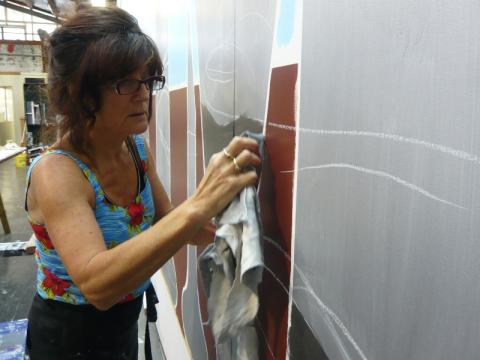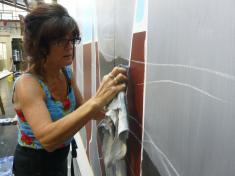Rob Garrett
Curator
Public Art
How to get involved
Public art is an exciting activity to be involved in. Opportunities are growing as Councils and private developers begin to see public art’s potential to signify creativity and innovation, and create a sense of pride and identity. The public arena is one of endless possibility – there are no gallery walls to limit your ideas, and you can potentially reach many more people than would visit a gallery. There are many reasons to get involved in public art but there are also some barriers. This article identifies some of these challenges and illustrates how you can overcome them.
The first challenge is to know what opportunities are out there. There are three main kinds of opportunities for artists interested in public art – Council commissions, private commissions and artist-initiated projects. These opportunities become available to artists in a range of ways. Council commissions are often contestable. Councils will approach a few artists and invite them to submit a proposal, or else they will put out an open call for proposals (in the form of a competition or a call for expressions of interest). Usually any artist can respond to an open call, regardless of their previous experience.
Private developers will occasionally put out an open call, but most often, they will commission artists directly. Only artists known to the commissioners will be offered these opportunities.
The third type of public art opportunity is artist-initiated. Artists create an opportunity by finding a space or site themselves that would suit an artwork. For example, an artist or group of artists may approach the owner of an empty shop to see if they can install a project there temporarily. This can be a great way to build experience, but getting permission to use the site may prove challenging: try bringing someone on board who has experience in working with the kinds of authorities concerned. (See the Tips Sheet below for further advice on this.)
So how do you get considered for public art opportunities? Firstly, it is vital that you have some experience in producing the kind of work that you would like to propose for a public commission. A successfully completed project will show the commissioner that you are capable of completing the project you are pitching for.
Secondly, make sure that you receive information about public art project briefs that might suit you. . Get in touch with your local Council’s arts advisers or planning officers and ask to be put on their database of artists so that you are kept informed of opportunities. Send your portfolio to Sculpture Trusts and register with other commissioners.
Most commissioners are looking for artworks that engage with a specific site and theme that they have identified for the project. For this reason, we don’t recommend putting time and effort into developing an idea for an artwork unless you are responding to a specific brief attached to a particular site.
Most public art work briefs require the art work to relate to its site in very specific ways. Some artists might see this as another form of restriction, thinking it means the artwork will be little more than a passive reflection of its environment. When commissioners use the term ‘site-specific’ they are usually thinking more broadly that this. ‘Site’ can refer to many things – from the communities of the proposed location, or former histories and stories associated with the location, to the spatial character, aesthetic qualities or uses of the location (such as traffic flow, retail, residential). The artist will be asked to respond creatively to the site and engage with its character. An artwork can be site-sensitive by contrasting, as well as by harmonising, with its environment.
Public art projects are usually very complex technically and there is much to organise. Artists can end up feeling like the demands of the project are distracting them from getting on with the art. Budgets, consents, supplies, writing statements, getting paid, technical and artistic issues are just a few of the things one can encounter along the way. Few artists will be as proficient in project management and advocacy as they are in developing creative ideas. But even when an artist is capable of doing it all by themselves, the more complex the project, the more stressful it is to ‘go it alone.’ It is important to get the right support in any given project in order to have maximum time for the creative content of the project.
Sometimes it is most efficient to hand parts of the project over to people whose core expertise lies in the area required. A specialised art project manager can coordinate the whole project, communicate with the client/commissioner, and bring in other expertise as needed. A skilled art project manager will also protect the artist’s idea and the artistic integrity of the project in the midst of all these helping hands, ensuring that the finished art work is as exciting as it was first imagined. Even experienced artists can benefit from bringing in external expertise, as John Radford found recently. We worked with Radford on Lux Flux, a light art project that he completed for Britomart. Radford says that professional project management helped him meet his deadlines and complete the project with a minimum of stress. Radford says professional support allowed him to focus more on what he is good at—the creative work—instead of wasting his energy on problems that could be solved by someone who specialises in those very things.
One of the most challenging situations that can arise in a large public art project is when the artist is asked to explain the artwork where some attendees are not completely on board with the need for an art component. A good art project manager can help here also as they will understand you as an artist; have a sophisticated grasp of the creative integrity of your ideas; and understand the value of art so they are able to advocate for you and your project in situations such as these. A good project manager will understand and speak your language as well as the language of Councils, administrators, developers and other commissioners. A good project manager will inspire confidence because they have excellent art knowledge coupled with a wide experience and an air of impartiality. Most importantly they will protect the project’s artistic integrity, leaving you to get on with what you are best at: imagining and making the art.
Tips Sheet: Meeting Public Art Challenges / “Getting Started”
How do I get experience in public art when I can’t get a commission without experience?
- Do the thinking required to make a public artwork—practice responding to a brief. Ask Council if you can have a copy of some past briefs, and practice preparing a submission. Plan the whole project as if you are actually going to do it. Then show it to someone who can give you advice such as an artist who has successfully responded to such briefs before. You can use your completed practice proposal as an example in your portfolio to demonstrate your ability to come up with public art concepts and to plan projects. This process will also help you identify whether you actually like working in this way.
- Work as an assistant to an artist who is working on a complex project.
- See if you can initiate a project yourself—find a suitable public space and get permission from the owner (and Council if necessary).
What is the best way to get approval to do an artist-initiated project on a public or private site?
- Get in touch with an organisation that has experience with the relevant authorities, whether they are private property owners or the Council. This could be an established artist’s collective, or an arts management company. These organisations will already have networks in place, or will be able to give you advice on how best to approach landowners in general.
I have built up some experience. What do I do next?
- Look for opportunities for emerging artists. Outdoor sculpture exhibitions that put out open calls for proposals can be a good start, and temporary public art festivals, like Auckland’s Living Room, are often open to proposals from emerging artists.
- Put in proposals for projects even if you think you won’t get them—it’s excellent practice in any case, and you never know.....!
How do I stay up to date with all the latest opportunities? How do I get shoulder-tapped?
- Commissioners need to know who you are and what you do! Send them your portfolio. (If you have never done this, or are not sure what the best approach is, you may find it useful to find someone to act as a sounding board or mentor for you.)
Should I send a proposal or a portfolio?
- If you are responding to a call for proposals, expression of interest, or a competition, a proposal is the most appropriate format to use.
- If you are sending information to a public art commissioner (Council, Sculpture Trusts, or Art Management companies) and you are not responding to a call for proposals, then send a portfolio.
What’s the difference between a portfolio and a proposal?
- A proposal outlines the concept, form and budget of a particular artwork that you are proposing for a particular site and purpose. It is sent in response to a call for proposals or as a competition entry. Each project brief will give specific guidelines about what the proposal should contain.
- A portfolio outlines your practice as an artist and your ability to do the kind of work commissioners are interested in. You send a portfolio in order to get registered on database of public artists. It informs commissioners of your practice, demonstrates your relevant experience and showcases the quality and style of your work.
What should my portfolio and proposal have in them?
- Relevant experience/examples of previous work;
- Referees who can attest to your ability to deliver quality artworks on time and within budget.
Proposals should conform to the format outlined, but in general, they also contain:
- A statement that outlines how the work meets the brief;
- A plan or sketch of the artwork, and/or a photograph of a model; and
- An estimated budget: how much will it cost to make (including your concept fees).
Rob Garrett and Amanda Wayers (2008)
Previously published in Art All: Artists Alliance Magazine, August/September 2008, pp18-19.

